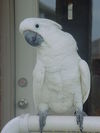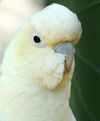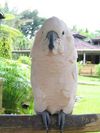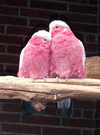Genus Cacatua

White Cockatoo - The White Cockatoo can live up to, and perhaps beyond, 80 years.
Ducorps - The Solomons Cockatoo , also known as the Ducorps' Cockatoo, Solomons Corella or Broad-crested Corella, is a species of cockatoo endemic to the Solomon Islands. This small white cockatoo is larger than the Tanimbar Corella yet smaller than the Umbrella Cockatoo. The species is common across most of the Solomons, absent only from Makira in the south. It inhabits lowland rainforests, secondary forests, cleared areas and gardens.
Sulphur-crested cockatoo - In Australia, Sulphur-crested Cockatoos can be found widely in the north and east, ranging as far south as Tasmania, but avoiding arid inland areas with few trees. They are numerous in suburban habitats in cities such as Adelaide, Canberra, Sydney and Brisbane. Except for highland areas, they occur throughout most of New Guinea and on nearby smaller islands such as Waigeo, Misool, Aru, and various Cenderawasih Bay and Milne Bay islands.
Goffin's Cockatoo - Tanimbar Corellas weigh, on average, about 250 g for females and 300 g for males. They are about 31 cm from head to tail.
Red-vented Cockatoo - The plumage is all white with red undertail coverts tipped white, yellowish undertail and pale yellow underwings. It is 12.2 inches long and has an 8.6 inches wingspan.
Major Mitchell's Cockatoo - The Major Mitchell's Cockatoo, Lophochroa leadbeateri, also known as Leadbeater's Cockatoo or Pink Cockatoo, is a medium-sized cockatoo restricted to arid and semi-arid inland areas of Australia. It is placed in its own monotypic genus Lophochroa.
Salmon-crested Cockatoo - In the wild the Salmon-crested Cockatoo inhabits lowland forests below 1000m. The diet consists mainly of seeds, nuts and fruit, as well as coconuts. There is additional evidence that they eat insects off the ground, and pet Moluccan cockatoos have tested positive for anemia if their diet does not include enough protein.
Blue-eyed Cockatoo - Like all cockatoos and many parrots, the Blue-eyed Cockatoo can use one of its zygodactyl feet to hold objects and to bring food to its beak whilst standing on the other foot; nevertheless, amongst bird species as a whole this is relatively unusual.
Western Corella - The Western Corella was formerly considered either a subspecies of the Little Corella or the Long-billed Corella, before being recognised as a full species. There are two subspecies:
Galah - The Galah , Eolophus roseicapilla, also known as the Rose-breasted Cockatoo, Galah Cockatoo, Roseate Cockatoo or Pink and Grey, is one of the most common and widespread cockatoos, and it can be found in open country in almost all parts of mainland Australia.
Little Corella - The Little Corella grows to 36 to 39 cm in length and congregates in flocks of up to several thousand birds, which often include many Galahs. The bird generally roosts in trees overnight, and flies off to feed in the early morning with an almost deafening screeching. It mostly feeds on the ground, eating seeds including cereal crops such as wheat and barley. It is so common that it has become something of a pest throughout much of Australia, and can be destructive to the trees in which it perches, by chewing the bark off smaller twigs. Corellas can be commonly found in the Melbourne suburbs of Camberwell and Ashburton, and are especially numbersome in Carrum Downs. This species has also a small feral population in Queanbeyan and Narrabundah.
Lesser Sulphur-crested Cockatoo - The Yellow-crested Cockatoo is found in wooded and cultivated areas of Timor-Leste and Indonesia's islands of Bali, Timor, Sulawesi and Lesser Sunda Islands. It is easily confused with the larger
Long-billed Corella - The Long-billed Corella is a monotypic species. It is one of several related species of Cockatoo called Corellas and classified in the subgenus Licmetis within the genus Cacatua, members of which are known as "white cockatoos".












